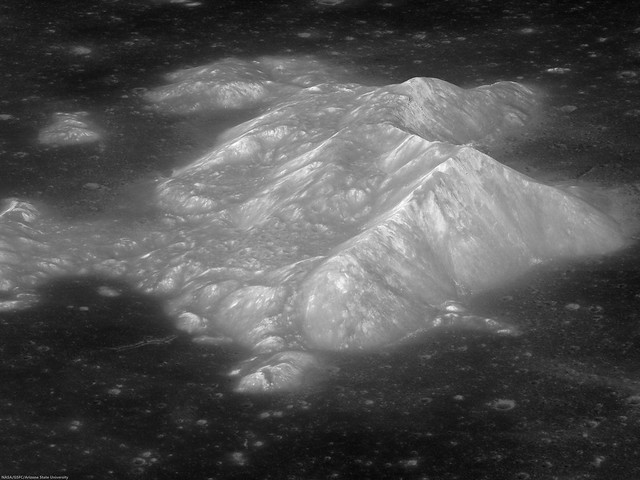 |
| LROC Narrow Angle Camera (NAC) oblique mosaic M1098059280LR (orbit 14176, July 27, 2012; angle of incidence 60.08°), the central peak of farside landmark Tsiolkovskiy crater. The image field of view is approximately 25 km across, the central peak rises 3.4 km above the mare-inundated crater floor. Spacecraft and camera slewed 64° far east of nadir, capturing the dramatic scene from 87.66 km over 20.44°S, 121.42°E [NASA/GSFC/Arizona State University]. |
Raquel Nuno
LROC News System
Today's Featured Image is a spectacular LROC NAC oblique view looking East at the central peak of Tsiolkovskiy crater. This large impact crater, with a diameter of 185 km, is located on the farside at 20.38°S latitude and 128.97°E longitude.
It is classified as a complex crater because of its terraced walls, scalloped rim, and central peak, which rises over 3400 m (11,150 ft) from the crater floor.
Central peaks of craters form in a matter of seconds from very energetic impact events. The tremendous pressure imparted from the impactor on to the target rock causes it to behave like a plastic for a few brief seconds. An imperfect analogy is a water droplet splashing into water, at first which produces a central jet, the fluid-like behavior of rock after the impact causes it to rebound upwards. Another factor assisting in the uplift of a central peak is the gravitational collapse of the crater walls which pushes material in the center upwards.
The floor of Tsiolkovskiy crater is partially flooded by mare basalt, which is the low reflectance smooth material seen in both the Featured Image above and the WAC context image below. The mare basalt on the floor of Tsiolkovskiy crater formed from basaltic lava that erupted after the crater formed and pooled. Mare basalts are predominantly seen on the lunar nearside; they make up the dark plains we are familiar with when we look at the Moon. This uneven distribution of mare basalts is thought to be due to the difference between the crustal thickness on the nearside and farside. The nearside crust is thinner, allowing easier access for basalt to flow up to the surface, whereas the thicker crust on the farside makes it so that only large impacts, like the one that formed Tsiolkovskiy crater, have enough energy to excavate deep enough into the crust to allow the release of basaltic lava.
The Tsiolkovskiy Crater was a Constellation Program region of interest because of the possibility to study the central peak, where astronauts could sample rocks that came from deep beneath the lunar surface.
Explore Tsiolkovskiy's central peak from an orbiting astronaut's perspective, HERE.
LROC News System
Today's Featured Image is a spectacular LROC NAC oblique view looking East at the central peak of Tsiolkovskiy crater. This large impact crater, with a diameter of 185 km, is located on the farside at 20.38°S latitude and 128.97°E longitude.
It is classified as a complex crater because of its terraced walls, scalloped rim, and central peak, which rises over 3400 m (11,150 ft) from the crater floor.
Central peaks of craters form in a matter of seconds from very energetic impact events. The tremendous pressure imparted from the impactor on to the target rock causes it to behave like a plastic for a few brief seconds. An imperfect analogy is a water droplet splashing into water, at first which produces a central jet, the fluid-like behavior of rock after the impact causes it to rebound upwards. Another factor assisting in the uplift of a central peak is the gravitational collapse of the crater walls which pushes material in the center upwards.
LROC interferometry and LOLA (laser altimeter) data, a brief tour of an advanced lunar Digital Elevation Model (DEM), in the vicinity of Tsiolkovskiy crater. "Tour of the Moon, Additional Footage," Science Visualization Studio [NASA/GSFC/SVS/ASU].
The floor of Tsiolkovskiy crater is partially flooded by mare basalt, which is the low reflectance smooth material seen in both the Featured Image above and the WAC context image below. The mare basalt on the floor of Tsiolkovskiy crater formed from basaltic lava that erupted after the crater formed and pooled. Mare basalts are predominantly seen on the lunar nearside; they make up the dark plains we are familiar with when we look at the Moon. This uneven distribution of mare basalts is thought to be due to the difference between the crustal thickness on the nearside and farside. The nearside crust is thinner, allowing easier access for basalt to flow up to the surface, whereas the thicker crust on the farside makes it so that only large impacts, like the one that formed Tsiolkovskiy crater, have enough energy to excavate deep enough into the crust to allow the release of basaltic lava.
 |
| It's difficult to step back far enough to grasp the area affected by this super-positioned impact in the farside southern highlands. This context image originally helped illustrate "Tsiolkovskiy central peaks at sunset," July 3, 2013 [NASA/GSFC/Arizona State University]. |
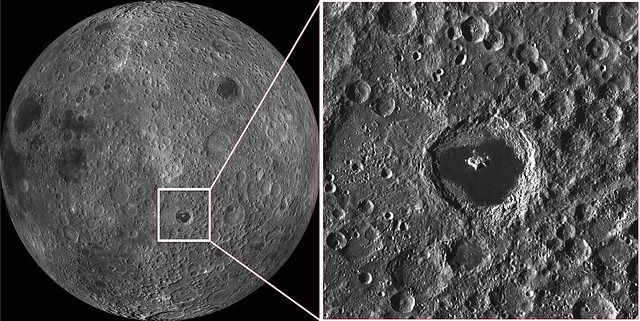 |
| On the left, LROC WAC monochrome mosaic centered at 120 degrees East longitude. On the right, LROC WAC context image of Tsiolkovskiy crater [NASA/GSFC/Arizona State University]. |
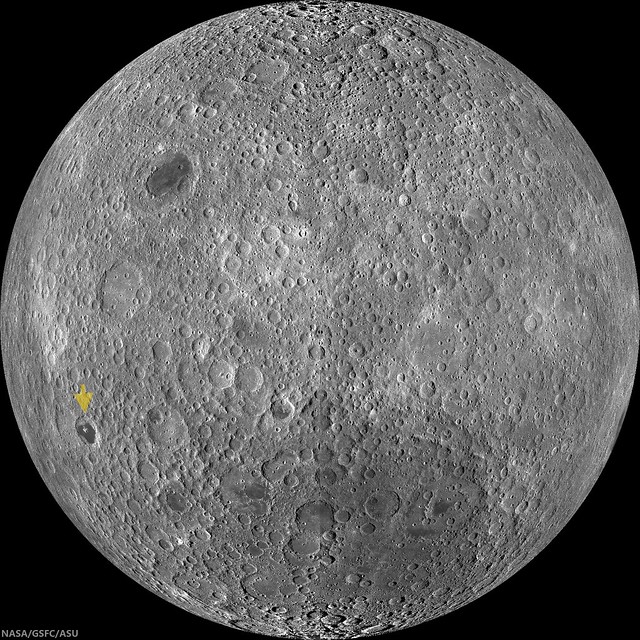 |
| Tsiolkovskiy easily stood out, a rare dark spot highlighting the surprising differences between the Moon's near and its farside when it was first photographed by the Soviet Union's Luna 3 in 1959. This LROC WAC mosaic, centered on 180° and the equator, was among the first LROC Wide Angle Camera images released. Tsiolkovskiy is marked by the arrow [NASA/GSFC/Arizona State University]. |
Explore Tsiolkovskiy's central peak from an orbiting astronaut's perspective, HERE.
Related Posts:
Tsiolkovskiy central peaks at sunset (July 3, 2013)
Bullialdus Central Peak Oblique (January 23, 2013)
New oblique view of Tsiolkovskiy central peaks (December 26, 2012)
The Old and the Young at Tsiolkovskiy (October 31, 2012)
The Old and the Young at Tsiolkovskiy (October 31, 2012)
Sampling a Central Peak (August 9, 2012)
Weaving boulder trails on the Moon (July 11, 2012)
Bulging wrinkles at Tsiolkovskiy (January 11, 2010)
Regolith on Basalt (January 10, 2012)
Follow the highlands-mare boundary in Tsiolkovskiy (September 29, 2011)
The Hummocks of Tsiolkovskiy (August 26, 2010)
More of Tsiolkovskiy's boulders and boundaries (August 26, 2010)
Small fractures in the mare floor of Tsiolkovskiy (August 25, 2010)
Tsiolkovskiy - Constellation Region of Interest (May 1, 2010)
Uplift, Boulders of Tsiolkovskiy (September 1, 2009)
Weaving boulder trails on the Moon (July 11, 2012)
Bulging wrinkles at Tsiolkovskiy (January 11, 2010)
Regolith on Basalt (January 10, 2012)
Follow the highlands-mare boundary in Tsiolkovskiy (September 29, 2011)
The Hummocks of Tsiolkovskiy (August 26, 2010)
More of Tsiolkovskiy's boulders and boundaries (August 26, 2010)
Small fractures in the mare floor of Tsiolkovskiy (August 25, 2010)
Tsiolkovskiy - Constellation Region of Interest (May 1, 2010)
Uplift, Boulders of Tsiolkovskiy (September 1, 2009)


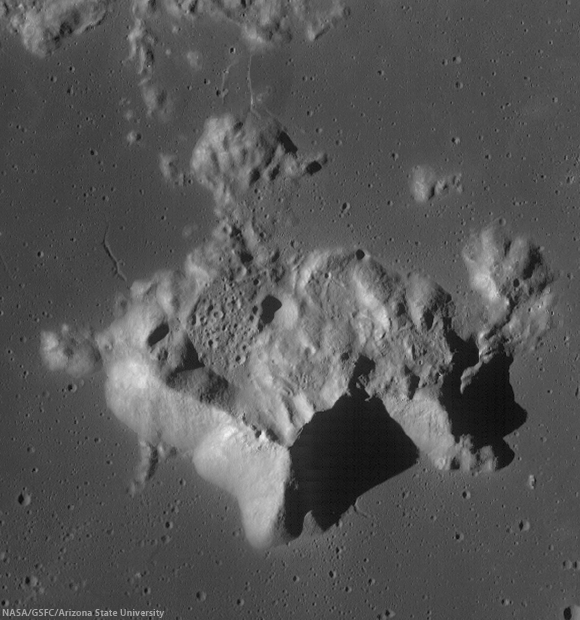
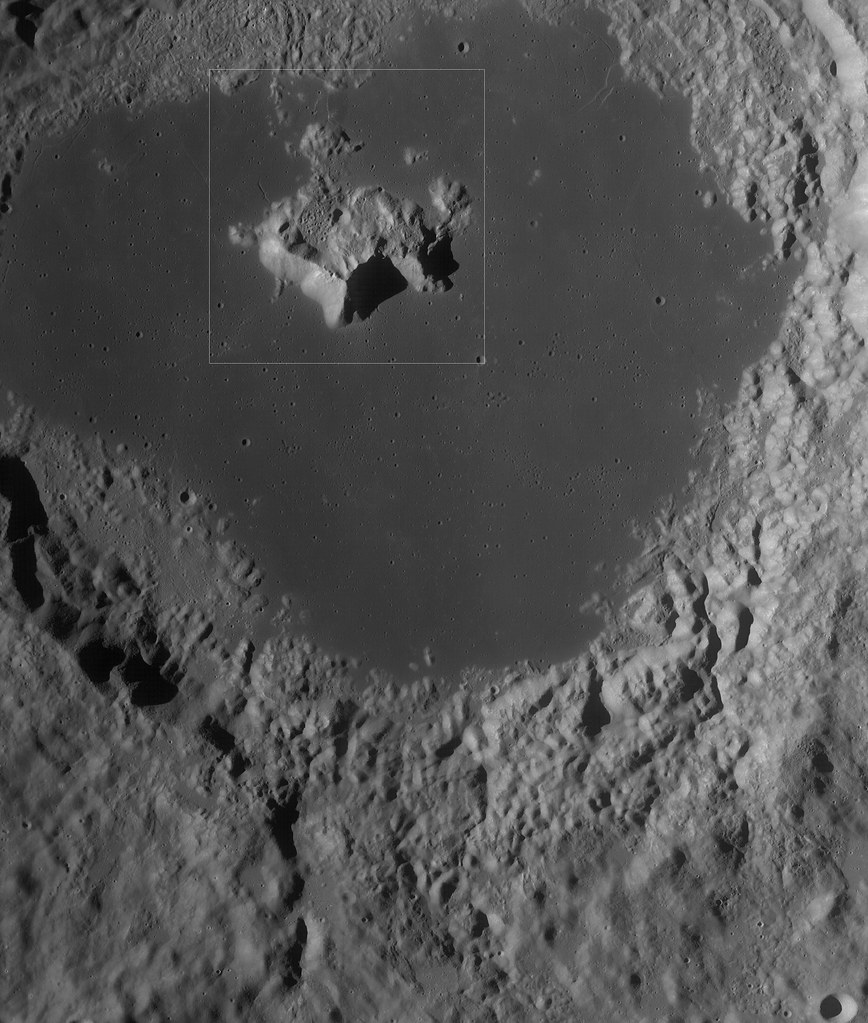
No comments:
Post a Comment